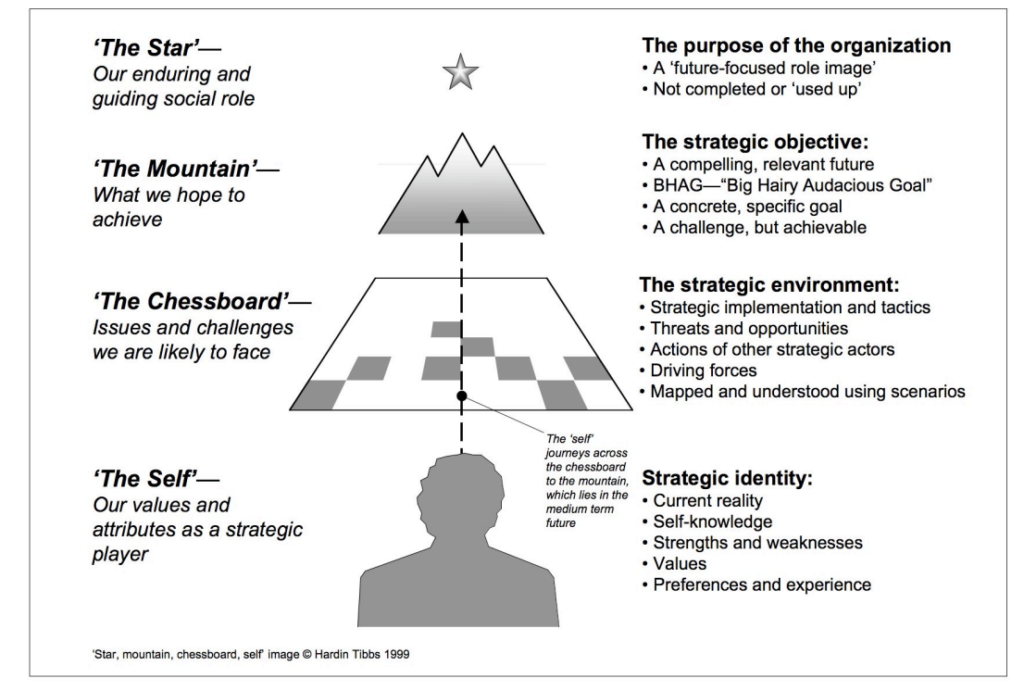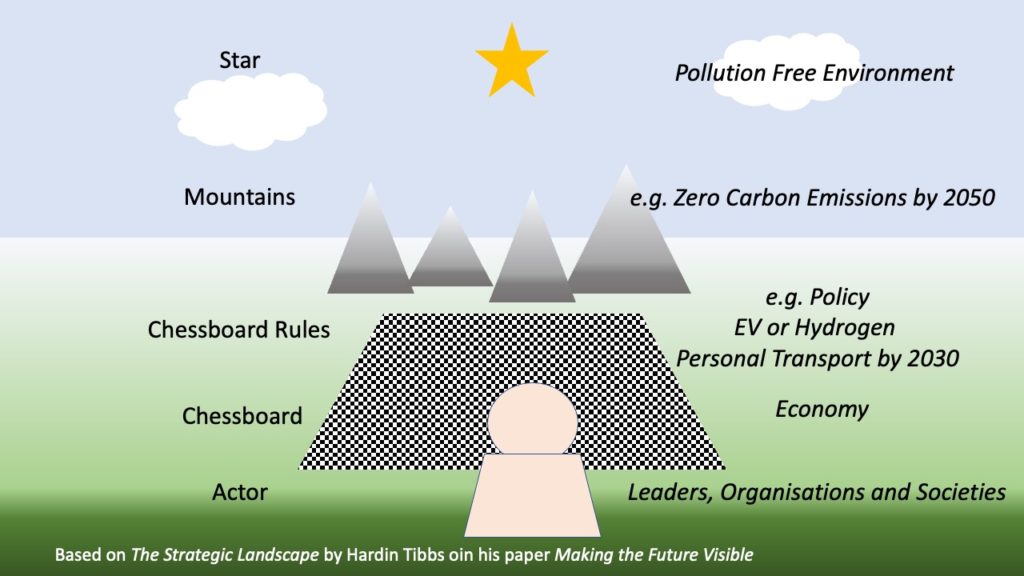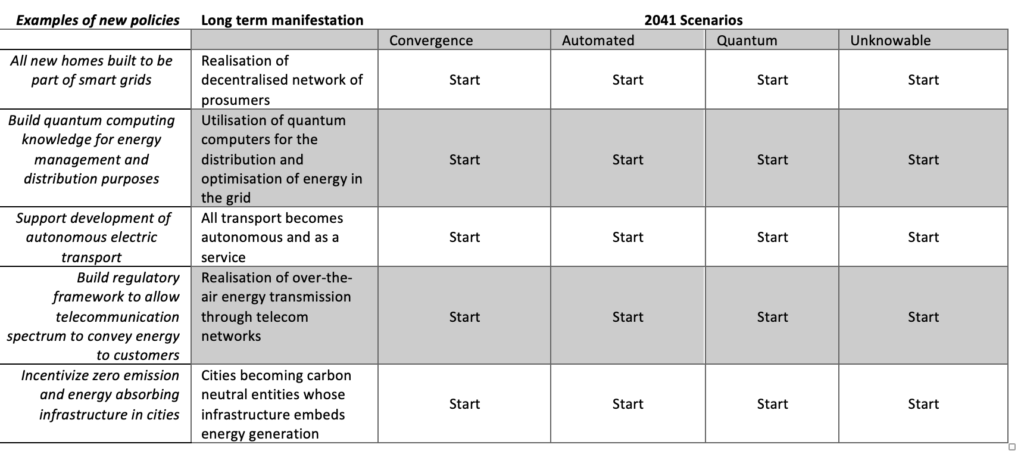Why foresight in policymaking
Foresight – structured thinking about the far future including multiple possible futures – is commonly used in policy making ( in Da costa et al. (2008) for the Joint Research Centre of the European Commission).
Foresight prepares for the unexpected. It generates informed conversations about the future, to uncover risks and opportunities and identify possible directions of evolution of present trends and technologies.
Most importantly for policymaking, foresight can help by prototyping preferred futures to aim at and identifying the appropriate actions that might lead to these futures, informing the very nature of policies.
The future as a landscape
A useful model to use here is the Strategic Landscape, derived from futurist Hardin Tibbs’ paper, Making the Future Visible. A picture of it is shown below:

Tibbs presents the Strategic Landscape beginning with the distant star representing the meta-goal, an enduring purpose guiding the strategic decisions of a country, for example, towards a pollution free environment.
In front of that are the mountains representing long-term goals, an example could be achieving zero carbon emissions by 2050. Before the mountains, and closest to the actor (i.e., organisations or individuals), is the chessboard.
The chessboard is the changing environment, the conditions, and competitors, that an actor might face on the way to the mountain top. The environment in our example includes changing climate, technological constraints and legislation i.e., policy. Our interpretation of the strategic landscape is pictured below:

Foresight helps in shaping the star and sculpting the mountaintops, but particularly identifies appropriate moves to be made on the chessboard. Those moves inform policymaking, whose role in this model is to intervene in the ecosystem and open the chessboard, facilitating the journey towards the mountain.
Continuing our point about zero carbon emission goals from before, we can foresee policies on renewable energy, electric or hydrogen vehicles, carbon capture, subsidising rail transport to replace short distance air travel and so forth.
These policies are a big part in determining which way the game will be played, and which pieces are moved, which are taken, and which are apparently inconsequential in the big game of chess.
A supportive set of tools
A practical example of how foresight can be useful for policymaking is wind-tunnelling through scenarios. Scenarios are prototyped futures that embed alternative ways by which the present might evolve. The idea behind it is to stress-test the robustness of policy options against a set of scenarios, to see how well they perform against a range of external conditions.
When used in conjunction with the strategic landscape, it becomes particularly powerful. In fact, the strategic landscape provides a way to benchmark or identify the aim of the policies. This adds top-down dimensionality to the wind-tunnelling exercise.
Wind-tunnelling example with scenarios
To explore wind-tunnelling in action, look at our table where existing UK energy policies are plotted against four scenarios of the possible future in 2041 (a project we recently completed in our Imperial Tech Foresight team). In the second table, we consider new possible policies emerging from the scenarios.

In the scenarios, the plausible evolution and combination of novel energy and computing technologies bring forth different ways by which humanity can tackle the future increase of energy demand and zero pollution targets.
- In Convergence, telecommunication networks evolve to provide over-the-air energy transmission, reshaping industry and smart cities. Battery usage and wiring cables become obsolete, dramatically reducing pollution and the use of natural resources.
- In Automation, ambient energy harvesting, and carbon capture become features embedded in modern city infrastructures, transforming them into self-sustaining, autonomous and zero pollution bodies.
- In Quantum, computational power from quantum computers is used to optimise and manage increasingly large and renewable energy powered smart grids. Computation becomes an essential tool for global success in integrating fluctuating sustainable energy sources.
- In Unknowable, fusion energy generation marks the end of fossil fuel utilisation, providing abundant and unlimited energy to societies. This brings forth novel paradigms of international collaboration and socio-economic stability, as well as problems that aren’t under consideration from our current policymakers.
Scenarios vs existing policies
For some insight into how current UK energy policies perform against these scenarios, let’s discuss the examples from the table below.

While policy number 1 is obviously effective for all four scenarios and should be continued, policy number 2, regarding the development of nuclear projects, could be stopped for Automation and Unknowable.
In fact, in the Automation scenario, cities self-produce enough energy to cover future energy demand although this may be episodic in nature. In Unknowable instead, fusion energy takes over previous paradigms of energy generation.
In policy number 4, the support towards the deployment of carbon capture technologies could be modified to include hard standards for commercial buildings in the Automation scenario. The intention being to facilitate their widespread implementation in city buildings.
New policies provoked by the scenarios
As can be seen in the second table below, the scenarios also create space for novel policies to emerge.

For example, investing in quantum computing technologies could be fundamental to manage the large smart grids of the future. Furthermore, as telecommunication networks evolve to accommodate over-the-air energy transmission, establishing a proper regulatory framework is needed to nourish competition and innovation in this area.
Wind tunnelling as a policy rehearsal
Wind tunnelling is also a pause in policy development that allows us to rehearse the future. It allows use the opportunity for a pre mortem. Consider the transition to electric vehicles. Rather than look at the comparative pollution costs to fossil fuel vehicles there are other considerations. For example, the carbon investment embedded in the production of existing fossil fuel cards being written off too early, the environmental costs of EV batteries, the carbon cost of new infrastructure and the use of bidirectional charging to reimagine the car as a household battery.
Conclusion
In conclusion, the wind-tunnelling exercise reveals the value of foresight and scenarios for testing policymaking against different conditions in multiple futures, to identify their fitness in multiple plausible futures and changing conditions.
The informative nature of foresight exercises can greatly benefit policies that aim at enabling positive and sustainable change and create actionable space for it to happen.
Interested in knowing more?
Wind-tunnelling is just one of many different techniques we employ when working with clients from around the world and across different sectors.
Imperial Tech Foresight is foresight backed with the scientific community of Imperial College London. Get in touch to learn more about the possibilities, challenges, and opportunities ahead.